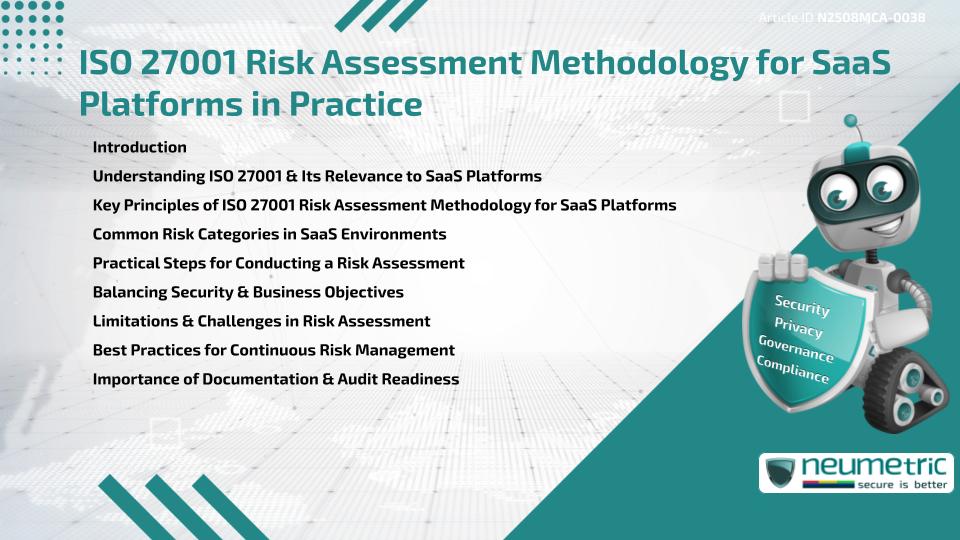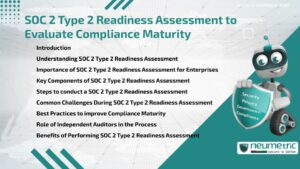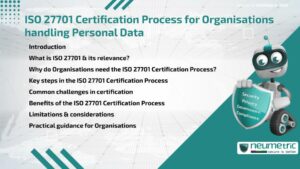Table of Contents
ToggleIntroduction
The ISO 27001 Risk Assessment methodology for SaaS platforms is a structured approach to identifying, evaluating & managing Information Security Risks within cloud-based software services. It helps Organisations ensure compliance with the ISO 27001 standard, maintain data confidentiality, integrity & availability & align Security Controls with Business Objectives. This methodology involves defining the context, identifying Risks, assessing their Likelihood & Impact, applying controls & continuously monitoring outcomes. For SaaS Providers, it plays a crucial role in building trust with customers, meeting regulatory requirements & protecting valuable digital assets.
Understanding ISO 27001 & Its Relevance to SaaS Platforms
ISO 27001 is an internationally recognised Standard for establishing & maintaining an Information Security Management System [ISMS]. SaaS platforms operate in highly interconnected & dynamic environments where data is constantly in transit & at rest across multiple systems. The flexibility of SaaS comes with inherent Risks, including potential data breaches, unauthorised access & compliance gaps. Implementing the ISO 27001 Risk Assessment methodology for SaaS platforms allows providers to apply a systematic process to anticipate & mitigate these Risks before they impact operations.
For example, a SaaS platform hosting Customer Financial data must comply with regulations such as GDPR or HIPAA. An ISO 27001-aligned Risk Assessment ensures that encryption, Access Control & backup Policies are robust & regularly reviewed.
Key Principles of ISO 27001 Risk Assessment Methodology for SaaS Platforms
This methodology rests on several guiding principles:
- Systematic approach: Risks are identified through a repeatable, documented process.
- Context-based evaluation: Risk Assessments are tailored to the organisation’s operational environment.
- Evidence-driven decision making: Findings are based on measurable data, not assumptions.
- Continuous Improvement: Risk Management is not a one-time exercise but an ongoing cycle.
Common Risk Categories in SaaS Environments
While each platform is unique, some Risks appear frequently in SaaS ecosystems:
- Data breaches due to weak authentication mechanisms
- Service outages from infrastructure failures or cyberattacks
- Insider Threats from Employees or contractors misusing privileges
- Third Party Risks from integrations with external tools
- Regulatory non-compliance due to insufficient control documentation
Practical Steps for Conducting a Risk Assessment
Applying the ISO 27001 Risk Assessment methodology for SaaS platforms involves:
- Defining the scope – Identify the assets, processes & systems included in the assessment.
- Identifying Risks – Use interviews, questionnaires & Vulnerability scans.
- Analysing & evaluating Risks – Determine Likelihood & potential impact.
- Selecting controls – Choose measures from ISO 27001 Annex A or equivalent.
- Implementing controls – Apply technical, administrative & physical safeguards.
- Reviewing & updating – Schedule periodic reassessments to adapt to changes.
Balancing Security & Business Objectives
Overly strict Security Controls may hinder innovation or User experience, while too few controls expose the platform to unacceptable Risks. The art lies in finding a balance where security supports business growth. For instance, Multi-Factor Authentication may slightly delay login times but significantly reduces unauthorised access attempts. Decision-making in this area should be guided by the organisation’s Risk appetite & Stakeholder expectations.
Limitations & Challenges in Risk Assessment
While effective, the ISO 27001 Risk Assessment methodology for SaaS platforms has limitations:
- Subjectivity in Risk scoring – Different assessors may rate the same Risk differently.
- Resource constraints – Small teams may struggle with the time & cost of thorough assessments.
- Rapid change in SaaS – New features & integrations can introduce Risks faster than they are assessed.
Acknowledging these challenges encourages the adoption of tools & practices that increase consistency & efficiency.
Best Practices for Continuous Risk Management
Continuous Risk Management is essential for SaaS platforms. Best Practices include:
- Regularly updating the Risk register
- Automating Security Monitoring where possible
- Providing staff with ongoing security awareness training
- Conducting supplier Risk Assessments for integrated services
- Scheduling at least annual reviews of Risk Treatment Plans
Following these practices ensures that the platform’s security posture evolves alongside technological & Threat landscapes.
Importance of Documentation & Audit Readiness
Proper documentation is not just for auditors; it creates a historical record of Risk Management decisions & actions. Clear, accessible records allow teams to trace incidents, justify control implementations & demonstrate compliance to regulators & clients alike. Audit readiness is a continuous state achieved through disciplined documentation habits, not a scramble before certification.
Takeaways
- The ISO 27001 Risk Assessment methodology for SaaS platforms offers a structured way to protect information assets.
- It helps Organisations comply with regulations & align Security Measures with business goals.
- Applying this methodology effectively can strengthen Customer Trust.
- It reduces exposure to operational & reputational Risks for SaaS Providers.
FAQ
What is the main purpose of ISO 27001 Risk Assessment methodology for SaaS platforms?
Its main purpose is to identify, evaluate & mitigate Information Security Risks within SaaS environments while maintaining compliance with ISO 27001 standards.
How often should a SaaS provider conduct a Risk Assessment?
At least once a year or whenever significant changes occur in the platform, infrastructure or Threat landscape.
Can small SaaS companies apply this methodology effectively?
Yes, but they may need to scale the process to fit available resources & prioritise the most critical Risks first.
Is ISO 27001 Certification mandatory for SaaS platforms?
No, it is voluntary, but it is highly recommended as it builds trust & demonstrates a commitment to security.
How does this methodology address Third Party Risks?
It includes assessing the Security Measures of Third Party services & ensuring contractual agreements cover Information Security responsibilities.
Need help for Security, Privacy, Governance & VAPT?
Neumetric provides organisations the necessary help to achieve their Cybersecurity, Compliance, Governance, Privacy, Certifications & Pentesting needs.
Organisations & Businesses, specifically those which provide SaaS & AI Solutions in the Fintech, BFSI & other regulated sectors, usually need a Cybersecurity Partner for meeting & maintaining the ongoing Security & Privacy needs & requirements of their Enterprise Clients & Privacy conscious Customers.
SOC 2, ISO 27001, ISO 42001, NIST, HIPAA, HECVAT, EU GDPR are some of the Frameworks that are served by Fusion – a SaaS, multimodular, multitenant, centralised, automated, Cybersecurity & Compliance Management system.
Neumetric also provides Expert Services for technical security which covers VAPT for Web Applications, APIs, iOS & Android Mobile Apps, Security Testing for AWS & other Cloud Environments & Cloud Infrastructure & other similar scopes. Reach out to us by Email or filling out the Contact Form…





